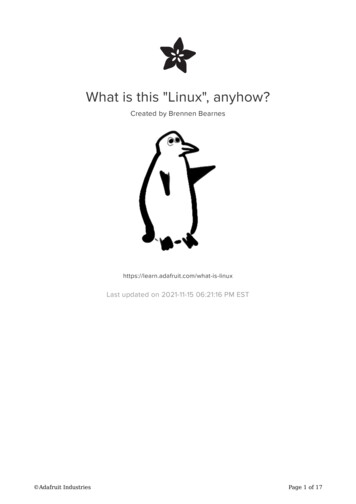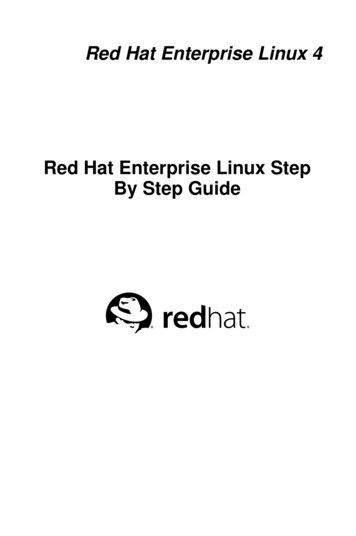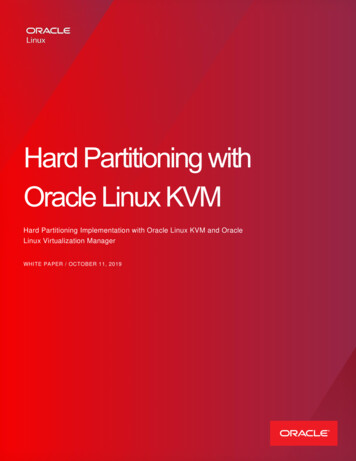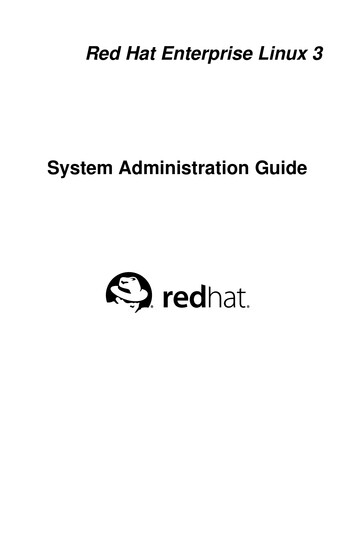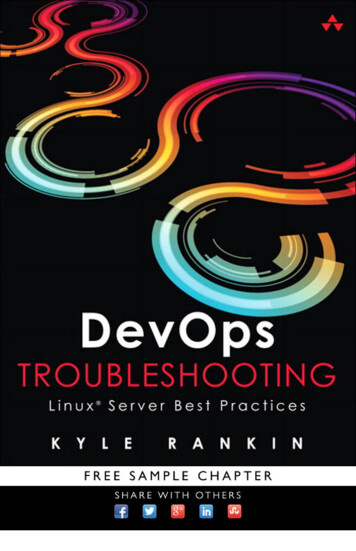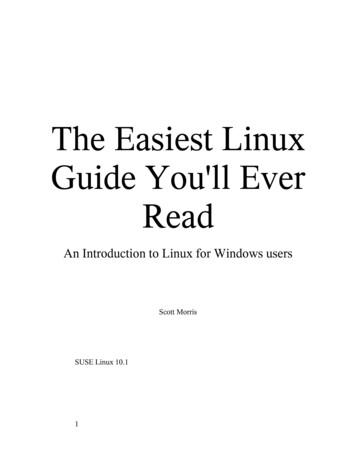
Transcription
The Easiest LinuxGuide You'll EverReadAn Introduction to Linux for Windows usersScott MorrisSUSE Linux 10.11
The Easiest Linux Guide You'll Ever ReadAn Introduction to Linux for Windows usersPublished byScott Morris – SUSE LINUX Rantswww.suseblog.comLicense under which this work is released: You can make unlimited copies of this work in its entiretyunder the condition that all of its contents remain intact, in the condition that they are found at thewebsite located at http://www.suseblog.com/ . Do not modify any part of this work prior to distributingto other parties. Scott Morris retains all copyrights to this work. Feel free to make as many copies asyou want, and give them to as many parties as you want. Just leave the content as it is.LIMIT OF LIABILITY/DISCLAIMER OF WARRANTY: THE PUBLISHER AND THE AUTHOR MAKE NO REPRESENTATIONS ORWARRANTIES WITH RESPECT TO THE ACCURACY OR COMPLETENESS OF THE CONTENTS OF THIS WORK AND SPECIFICALLYDISCLAIM ALL WARRANTIES, INCLUDING WITHOUT LIMITATION WARRANTIES OF FITNESS FOR A PARTICULAR PURPOSE. NOWARRANTY MAY BE CREATED OR EXTENDED BY SALES OR PROMOTIONAL MATERIALS. THE ADVICE AND STRATEGIESCONTAINED HEREIN MAY NOT BE SUITABLE FOR EVERYT SITUATION. THIS WORK IS SOLD WITH THE UNDERSTANDING THATTHE PUBLISHER IS NOT ENGAGED IN RENDERING LEGAL, ACCOUNTING, OR OTHER PROFESSIONAL SERVICES. IF PROFESSIONALASSISTANCE IS REQUIRED, THE SE4RVICES OF A COMPETENT PROFESSIONAL PERSON SHOULD BE SOUGHT. NEITHER THEPUBLISHER NOR THE AUTHOR SHALL BE LIABLE FOR DAMAGES ARISING HEREFROM. THE FACT THAT AN ORGANIZATION ORWEBSITE IS REFERRED TO IN THIS WORK AS A CITATION AND/OR A POTENTIAL SOURCE OF FURTHER INFORMATION DOES NOTMEAN THAT THE AUTHOR OR THE PUBLISHER ENDORSES THE INFORMATION THE ORGANIZATION OR WEBSITE MAY PROVIDE ORRECOMMENDATIONS IT MAY MAKE. FURTHER, READERS SHOULD BE AWARE THAT INTERNET WEBSITES LISTED IN THIS WORKMAY HAVE CHANGED OR DISAPPEARED BETWEEN WHEN THIS WORK WAS WRITTEN AND WHEN IT IS READ.Copyright 2006 by SUSE LINUX Rants, Salt Lake City, UTFirst Edition, 2006Published in the United States of America2
About the AuthorScott Morris began using computers over 20 years ago, at the age of 10. He hasused 25 different versions of 5 different operating systems over this time period. Ofthose many operating systems, he has experience using MS-DOS, Windows 95,Windows 98, Windows 2000, Windows XP, and Mac OS 9.x – X. He has enjoyedusing many different distributions of Linux, including Mandrake, Red Hat, Gentoo,Fedora Core, Debian, and SUSE.He has worked recently as Editor of the Novell CoolSolutions Linuxcommunities. During his employment there, Novell, along with many other newsoutlets, has published over 110 of his articles. He gets particular enjoyment out ofhelping people discover the excitement of the Linux operating system. Articles hehas written can be found on his author page, located .html .He also has a personal blog, located at http://www.suseblog.com, which he usesfor personal enjoyment and to help others. He writes opinions, news, tips, and tricksabout the SUSE Linux operating system. This blog is a light-hearted resource forbeginning Linux users. The latest version of this book can be found at this website.3
Table of ContentsWho should read this book.7An introduction before we start.9More familiar than you think.9Common Myths.10Things to know about Linux.13Getting Help and Learning More.18General reading material.18Forums.19Mailing Lists.19Other Resources.20How do I get Linux?.21Download Linux and put it onto CDs.21Purchasing Linux Installation CDs.23Installing SUSE Linux.23Installation Options.23Linux-only Installation.24Beginning the Installation.25Sharing the computer between Linux and Windows.58Beginning the Installation.59Introduction to Users and Groups.89Get to Know Your Desktop.90What is KDE?.90The K Menu.91The Kicker Panel.94The KDE Control Center.944
Changing Mouse Behavior.95Changing Time and Date Display Format.99Window Themes.104Desktop Preferences.111Konqueror: filesystem and web browser.116Browsing through your files.116As a web browser.118Kicker Panel.119Installing Office Writer.130OpenOffice Calc.132Thunderbird.135Setting up your email account.136Sending and receiving email.146Firefox.147So you want to use the command line?.153View directory contents with 'ls'.155Make a directory with 'mkdir'.156Remove a directory with 'rmdir'.156Change to a directory with 'cd'.157What directory am I in? Using 'pwd'.157Copying files with 'cp'.158Moving files with 'mv'.158Deleting files with 'rm'.159Viewing text files with 'cat'.159Viewing text files with 'less'.1605
What time is it? What is the date? Using 'date'.160Using 'man' to find help.161Conclusion.1626
Who should read this bookThis book is geared towards Windows users who want to take a look at Linux.Are you interested in trying Linux on your computer? If so, you have found theperfect book. In this book, I will give you a gentle introduction into using Linux,and help you ease into it. The only technical skills you should have includebrowsing the Internet and downloading files. It will help if you have burned yourown CDs before, but such skills are not required. If you have a computer geekhandy, that also couldn't hurt. The purpose of this book is to make it easy to try theLinux operating system, particularly for people who are used to Microsoft Windows.Even if you only use your Windows computer for checking email and surfing theInternet, this book was written just for you.Having used Windows myself for nearly 15 years, I was very used to thatplatform. I didn't realize how used to it I was until I tried to use something else. Asan illustration of what I mean, let's say that you download Linux, and eventuallyfigure out how to download Linux. Even when you finally do get it installed, it issomewhat of a bitter-sweet triumph. On the one hand, you feel good about havingsuccessfully gotten that far.On the other hand, after you have installed it, you sit there, staring blankly atyour new desktop wondering what in the world to do next. You may feel somewhatlost. You have heard how wonderful Linux is, but don't know why, or how to makeit perform all the impressive tricks. In many cases, you don't even know what thosetricks are (at least I didn't when I first started).If you are considering trying out Linux on your desktop, but have some anxietyabout learning everything, from this point on, you have no need to worry. We willtake it one step at a time. The top priority of this book is to make everything as easyto learn as possible. I am going to give as much background and explanation as Ican.7
My goal is that you understand the purpose and concepts involved with each stepthat we take. I want to go over the why as well as the what. The more youunderstand, the better your foundation will be. A good, strong foundation provides asolid base upon which you can build as you learn more. This helps you learn moreefficiently, and retain more of what you learn in the future.Before we try and get Linux to install it, we will discuss some fundamentaltopics. When you are switching from Windows to Linux, there are someexpectations that you will need to change. You are going to be using a brand newplatform. You cannot assume that the new platform to be equivalent in all aspects tothe old one.To begin with, we will mold your expectations. If you know what to plan on,your experience will be more pleasant. In other words, there is a mental shift thatwill take place as well as you switch platforms from Windows to Linux. I want tomake that shift as easy and pleasant as possible for you.If all goes well, this introduction will be painless. At very least, I hope to makethe migration process as enjoyable and easy for you as I can.Your experience will gradually increase as we explore the various aspects of theLinux operating system. As this occurs, you will have questions. You will want tolearn more about different things. If, heaven forbid, something goes wrong withyour system, you may wish to seek help. You may want to interact with other Linuxenthusiasts. You may even wish to share what you have learned with others.There is almost an endless list of online resources and communities that willaddress all of these issues and plenty more. I will share with you many greatresources that you can use to learn more about Linux. Hopefully, I will be able tohelp you know where to go for each of the different types of help or information thatyou seek. This way, if you have a question that I do not address here, you will knowwhere you can find your answer.8
An introduction before we startWhen you want to learn about something new, what do you do? Research! Youlikely go online and look things up, go to the library, and talk to anybody who mayknow something about it. Only this time, you don't have to do any of that. I havealready done all of this for you. You have everything you need right here to getstarted with Linux. How easy is that? Grab a Coke, take this book, and head to yourfavorite armchair. We are going to discuss some of the things that set Linux apartfrom other operating systems.Because of how adaptable it is, there are actually several different kinds of Linux.In the Linux world, we say that there are different distributions. The most populardistributions of Linux include Red Hat, Ubuntu, SUSE, Mandriva, Debian, andFedora Core. Perhaps you have heard of some of these. One of the easiestdistributions of Linux to use is SUSE Linux. It is this distribution that I will beworking with in this text.First, we will look at some of the ways that SUSE Linux will feel natural to you.It is different, to be sure. However, you will be surprised at how much of it feelsfamiliar to you.Conversely, we will also go over some of the ways that SUSE Linux will beforeign to you. Because honestly, using Linux is different than using Windows. Wewill look at these differences and make sure you are comfortable with them beforewe move on.More familiar than you thinkTo start out in your comfort zone, let's look at the parts of Linux that will feelfamiliar to you. There is quite a bit more that falls into this category than you mightthink. For example, you have a graphical desktop just like you do on Windows. Ithas a screen saver, wallpaper, icons and windows, just like you are already used to.You can set the wallpaper to your favorite picture. There is a mouse pointer that you9
move around the screen. You use this mouse cursor to select and click on things.There are icons on the desktop that you can click to open. There will be a veryfamiliar windowing system that functions much like what you are already used to inWindows.Not only will the desktop be similar to what you are familiar with, but manyapplications will be, also. You have a fully-functional word processor that will workmuch as you expect it to. Browsing the Internet is simple. In many cases, you willuse Firefox, the same program you may already use on Windows to surf the web.Other functionality that Linux offers to you includes email, spreadsheets, mp3players, video players, and printing; all concepts with which you are very likelyalready used to. Truth be told, you already know much of how to use Linux. Morethan you think you do.Common MythsTo put you more at ease, I want to dispel some common myths people have aboutusing Linux. Peoples' interest in this amazing platform has suffered a bit becausethey believe things about Linux that are not true. In some cases, they were true inthe past, but not anymore. When we see that these are mere myths, the path tolearning Linux becomes considerably easier. What are some of the most commonmisconceptions about Linux?Myth #1 : Linux is too hard for a regular computer user. I have heard that it is onlyfor computer geeks because it is too hard to use.At the present time, this is complete nonsense. In the beginning, setting up andinstalling Linux and its programs had to be done by hand at a command prompt.Yucky. However, within the last few years, many types of Linux have becomesimple enough that young kids are able to install and use them. I have also heardstories about folks well-advanced in years setting up and using Linux. When youfirst install most types of Linux nowadays, you don't even see the command prompt.10
You don't have to work in the command line at any time. This is especially trueafter you are done installing Linux. Almost the entire operating system can beaccessed through graphical, window-based screens. In almost all cases, this includesthings like installing software or configuring some aspect of the system. Linux, inmost situations, has become quite point-and-click. Once you learn where things are,nearly everything can be accessed through the graphical windows. This is one of thebiggest things that makes using Linux easy.Myth #2 : Linux has a very limited selection of software.There is definitely a lot of software available for Windows. In reality, there is agreat overabundance. Linux provides a narrower selection of higher-qualityprograms. Let's talk about email programs, for example. On Windows, I have triedaround 60 different email programs. Of those, about six are mainstream, wellsupported, widely used applications (Outlook, Outlook Express, Eudora,Thunderbird, Pegasus, and The Bat). It makes sense that if a great number of peopleare using a program that it will probably be around for a long time. Not only that,but there are more people who you can ask for help. I recommend using such typesof programs wherever possible. For Windows, there are about five mainstreamemail programs.On Linux, there are also a handful of them, such as Thunderbird, KMail, Balsa,Mozilla Mail, Opera, and Evolution. On average, the number of available Windowsprograms is overkill several times over. With Linux, you still have a nice handful ofchoices without having to sort through an ocean of options. There are fewerapplications available on Linux. That said, the quality of the good ones is very easilyjust as good as, in many cases better than, what you find on Windows. This is trueespecially in recent years, as some applications have reached industrial-strength,enterprise-ready stages of development. Many such applications are employed infull-time use at real companies throughout the world. In the case of email, Irecommend using Thunderbird. I will introduce this program along with some othergreat software later in this book.11
Myth #3 : If Linux and its software are free, they must not be very good quality.Quite the opposite is true. Most of the software that runs on Linux is not ownedby any one person or company. It is open to the community. This means thatanyone who wants to can work on the program and make it better. They do itbecause they want to improve the software, as they get no other monetary gain fromtheir work. Thus, many such programs have thousands and thousands ofprogrammers working on them to make them genuinely better.With proprietary systems, the code is generally managed by a small team ofprogrammers who are under great pressure to get their software finished. In somecases, the software is released with bugs and problems in it so that the consumermust be dependent on the vendor for upgrades and fixes.Because of all of this, many times Linux software is superior to Windowssoftware. This is one of the reasons that Linux has been and still is much moresecure than Windows. It has many thousands of people worldwide working to makeit as good as it can be. When problems are found, they are fixed within a day or two,and many times within a few hours.With these few things set straight, we can begin learning more about the Linuxoperating system. There will be many things similar to what you have already usedon Windows. There are also some things that will be different for you. Some thingsare only minor adjustments. Other things may take a little more getting used to.In any case, we will not rush through anything in this book. I'd like to make surethat you are as comfortable as possible with the concepts that we discuss. Using thefree Linux operating system can be quite rewarding to use. Perhaps the mostobvious benefit is in how much money you will save. Hopefully, we will also beable to make it as fun and as enjoyable as possible for you.12
Things to know about LinuxWe have looked at ways that Linux will feel familiar to you. While there aremany, there are some things that may feel a little different. Truthfully, many thingsare slightly different. These will take no time at all to get used to. That said, thereare other things that may take a little longer for you to adjust to. I would like to takea few moments to briefly discuss some of these differences. That way, when we getfurther into this book, you will know what to expect. Let's take a look at some of themajor differences between Windows and Linux, and talk about them one at a time.This will give you greater insight and understanding into how Linux works.#1 : Linux is very versatile and configurable.One of the somewhat astounding strengths of Linux is its versatility. It can run asa web server, a desktop, or embedded into other systems. There is a distribution ofLinux that runs on the Space Shuttle. There is one that controls a military vehiclethat actually drives itself. In Canada, they are using Linux to manage coin-operatedmeter maids. Other distributions run on myriads of electronic devices, such asApple's iPod.Because Linux is so versatile, there are many many ways to perform the sametask. This may be one of the things that makes people think Linux is so complex.When you are trying to accomplish a task, you may find that there are several waysto accomplish that task. In such cases, it may help to ask a friend familiar withLinux how they do it. Having a mentor available is one great way to get help withyour Linux system. If you don't know anyone who knows Linux, please do notworry. There are innumerable resources online where you can turn for help, which Iwill discuss a little later in this book. As you visit these resources regularly, you willmeet people who can help you. Within no time, you will have many online friendswho you can ask for help.#2 : Getting Help with Linux13
Speaking of getting help, the Linux way is going to be a little different than whatyou are used to. When you have trouble in Windows, you may be used to callingtechnical support for help. I think that many people prefer to go to a live person forhelp. In many cases, this does usually fix the problem.However, with this model of problem resolution, you don't usually learn muchabout what caused the problem or how to fix it next time it occurs. Because of thenature of how you find help with Linux, you do learn quite a bit in the process.Some of the time, this process involves research done on your own. Do notinterpret this to mean that you are completely on your own. Far from it, as it turnsout. Once you have fixed a handful of problems, the process of doing so willbecome second nature for you.At a later portion of this book, I will outline several very efficient ways ofseeking help when things go south. Some of these involve doing your own research,and others methods involve asking other people for help. We will look at how to usesome of the great resources. I will demonstrate how easy it truly is to get help withLinux. If you enjoy browsing and reading, many of the resources we will discusscan be used for learning more about Linux.#3 : The Command LineIn Windows, it is very rarely necessary to use the DOS prompt. In moderndistributions of Linux, you are perfectly able to use your computer without evertouching the command line. In the past, this was not the case. For a long time, whenyou wanted to learn Linux, you had to know the command line inside and out. Withsome of the more recent flavors of Linux, you can get away without knowinganything about the command line.That said, one of the major differences between Windows and Linux is the powerof the command line. In Windows, it has minimal value, and provides little usefulfunctionality. In Linux, on the other hand, the command line interface provides a14
wealth of powerful features, more of which we will discuss later on in this book. Fornow, it is sufficient to know that if you want to truly say that you know how to useLinux, you should take the time to learn how to use the command line. When we doexplore this powerful tool, I will take you through some of the most basiccommands.#4 : Software InstallationI am going to assume that you have installed software on Windows. The processis somewhat simple. You search online for a cheap or free software package thatdoes what you need it to do. You download it to your computer. When thedownload completes, you usually will double-click on the file you just downloaded,starting the installation process. Most of the time, you just click NEXT severaltimes, and eventually the software gets installed.The way you install software on Linux is somewhat different than this. If you areusing SUSE Linux, the software is all installed with one program, called YAST.This application makes installing software a snap. The basic premise is that youopen YAST and do a search for the software you want. In the results that come up,you just check a little box next to the program that you wish to install. You thenclick a button, and YAST goes about its business of installing your software. Mostof these programs will reside on the several different installation CDs which you willalready have. No need to go hunting around.#5 : Security in LinuxOne of the overwhelming strengths of Linux is its rock-solid security. With somany thousands of people working on it worldwide, security holes and bugs arefound and fixed quickly. One of the great things about this is that you may onlyhave to wait for a few days to get updates. With Windows, studies that have beendone have found that you have to wait for about six weeks for security updates. Thisis bad news. Even worse, hackers know about the security hole for at least four ofthose six weeks. That means for nearly a month, you run a much higher risk of a15
hacker using that security hole to break into your systems. With Linux, by the timethe hackers know about a security issue, there are already updates available to fixyour system. That sounds like a much better deal to me.In addition to having quick security updates available, even an unpatched Linuxsystem left out in the open on the Internet is more secure than a similarly unpatchedWindows system. Studies have found that unpatched Linux systems left on theInternet last at least four months without being broken into. Unpatched Windowsmachines last, on average, about 70 minutes.In my personal experience, I have had Windows computers broken into before Iam even done installing Windows on them! I have to keep the computer off theInternet until I am completely done installing Windows, applying all the patches(which you have to be connected to the Internet to even get), and installing all of theanti-spyware, anti-virus, and firewall software. Only then do I cross my fingers andplug it into the Internet. Rather than go through all that anxiety, it is just less hassleto use Linux.Because Linux is not susceptible to about 99.6% of known viruses and spyware,there are very few anti-virus applications available for it. Do not let this deter you.Because Linux is so secure, there is almost no need for an anti-virus software. Oranti-spyware software. Linux does, however, have an industrial-strength firewall.This is another reason that it provides full security.Along this same vein, the processes, files, and directories are controlled by a verystrict privilege system. Because of this, a user will have permissions to access somethings but not others. For example, regular users do not have access to systemcommands or files. If they did, you can imagine that the system could be breachedvery quickly. Windows has no such clearly defined access control. This is anotherreason that Linux is very secure. You can count
distributions of Linux include Red Hat, Ubuntu, SUSE, Mandriva, Debian, and Fedora Core. Perhaps you have heard of some of these. One of the easiest distributions of Linux to use is SUSE Linux. It is this distribution that I will be working with in this text. First, we will look at some of the ways t





